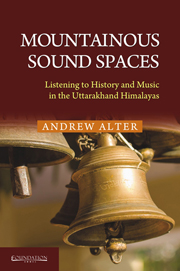Book contents
- Frontmatter
- Contents
- List of Figures
- List of Tables and Musical Examples
- Preface
- Acknowledgements
- Introduction
- 1 Echoes of Colonialism: Bagpipes in the Himalayas
- 2 Echoes of a Royal Heritage: Vestiges of Naubat
- 3 Possession and Performance: Sounding Out the Epic Worlds of Heroes and Gods
- 4 Worlds of Sound: Revisiting the Parameters of Oral Tradition
- 5 Flutes, Sprites and Mountainous Geographies
- 6 Drum Strokes, Syllables and Rhythmic Patterns
- 7 The Significance of Tantric Sects for Drum Practice in the Central Himalayas
- 8 Playing History: Sounding Out the Epic Worlds of Heroes and Gods
- 9 The Legacy of Garhwali Cassettes: Remembering the Pre-digital Age of Music Commodification
- Epilogue: Listening to an Uttarakhandi Himalayan Space
- Bibliography
- Index
7 - The Significance of Tantric Sects for Drum Practice in the Central Himalayas
Published online by Cambridge University Press: 05 October 2014
- Frontmatter
- Contents
- List of Figures
- List of Tables and Musical Examples
- Preface
- Acknowledgements
- Introduction
- 1 Echoes of Colonialism: Bagpipes in the Himalayas
- 2 Echoes of a Royal Heritage: Vestiges of Naubat
- 3 Possession and Performance: Sounding Out the Epic Worlds of Heroes and Gods
- 4 Worlds of Sound: Revisiting the Parameters of Oral Tradition
- 5 Flutes, Sprites and Mountainous Geographies
- 6 Drum Strokes, Syllables and Rhythmic Patterns
- 7 The Significance of Tantric Sects for Drum Practice in the Central Himalayas
- 8 Playing History: Sounding Out the Epic Worlds of Heroes and Gods
- 9 The Legacy of Garhwali Cassettes: Remembering the Pre-digital Age of Music Commodification
- Epilogue: Listening to an Uttarakhandi Himalayan Space
- Bibliography
- Index
Summary
Gorakhnath is a tantric figure revered by a number of Hindu Shaivite sects. These sects exist particularly in Nepal, but are also found elsewhere in, or near, the Himalayas as well as in parts of northern India including Rajasthan and Bengal. However, Gorakhnath is a particularly significant figure for many in the Himalayas. For instance, Maskarinec (1995: 7) mentions that shamans in Nepal regard Gorakhnath as the ‘highest’ spiritual authority. The suffix –nāth literally means ‘lord’ or ‘master’, and thus is used in many contexts. Most broadly, this suffix is used in association with the names of specific temples and their principal deities, such as Kedarnath, Tungnath, or Bodinath, highlighting the reverence people hold for these places of worship and their deities. In addition many people more generally refer to ‘Naths’ as those who follow the teachings of Gorakhnath. They are also referred to as Gorakhpanth – meaning the sect(s) (paṅth) of Gorakhnath.
Little is really known about Gorakhnath as an actual historical figure. He may have lived about a thousand years ago and his teachings as well as those of his guru, Matsyendranath, have shaped an esoteric philosophical tradition that is carried on today by Gorakhpanthis. Kanphata Yogis are the most well-known sect of ascetics who revere Gorakhnath as their founder and primary gurū. As Bharati (1982: 873) suggests, the sect is not only a tantric (Shaivite and Shakta) order but also has connections with the Vajrayana Buddhist tradition.
Information
- Type
- Chapter
- Information
- Mountainous Sound SpacesListening to History and Music in the Uttarakhand Himalayas, pp. 97 - 108Publisher: Foundation BooksPrint publication year: 2014
